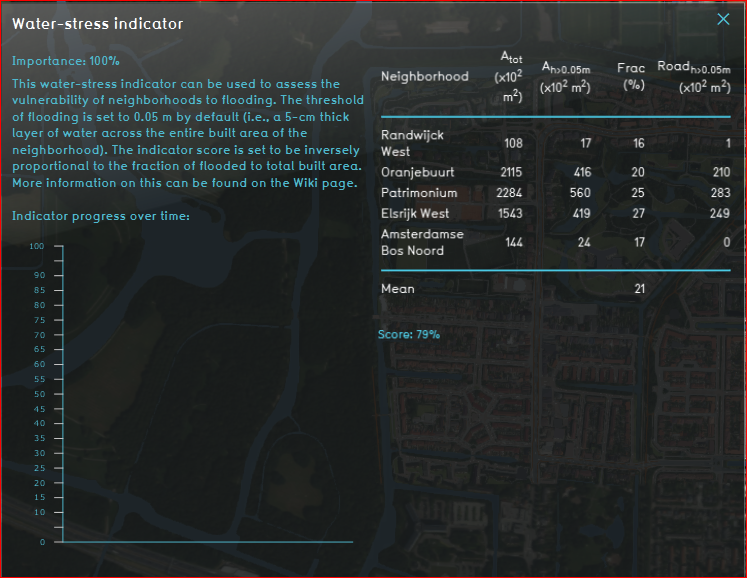Water stress (Indicator): Difference between revisions
No edit summary |
No edit summary |
||
| Line 1: | Line 1: | ||
{{learned|what the water stress indicator is|about its possible applications|about its underlying calculations|the | {{learned|what the water stress indicator is|about its possible applications|about its underlying calculations|about the required preparations|about ways to expand its functionality}} | ||
==General== | ==General== | ||
| Line 22: | Line 22: | ||
A progress bar, that runs from 0 to 100%, keeps the user updated about the current state of the neighborhoods in their project in terms of flood resilience. The indicator score is set to be inversely proportional to the fraction of flooded (i.e., exceeding threshold) to total built area (averaged over the neighborhoods present in the project). For instance, if on average 21% of the built area exceeds threshold, the score will be set to (100-21=) 79%. The user decides whether they whish to display the [[Indicators#Absolute_score|absolute or relative score]]. Naturally, a higher score means better flood resilience and vice versa. | A progress bar, that runs from 0 to 100%, keeps the user updated about the current state of the neighborhoods in their project in terms of flood resilience. The indicator score is set to be inversely proportional to the fraction of flooded (i.e., exceeding threshold) to total built area (averaged over the neighborhoods present in the project). For instance, if on average 21% of the built area exceeds threshold, the score will be set to (100-21=) 79%. The user decides whether they whish to display the [[Indicators#Absolute_score|absolute or relative score]]. Naturally, a higher score means better flood resilience and vice versa. | ||
=== | ===Preparation=== | ||
In order for the indicator to work properly, a variant of the [[Water Overlay]] needs to be added to the project, and its [[Excel#ID_queries|ID]] | In order for the indicator to work properly, a variant of the [[Water Overlay]] needs to be added to the project, and its [[Excel#ID_queries|ID]] should match the number (#) as it appears in the queries containing WHERE_GRID_IS_# found in the ''indicator.xlsx''. Once an overlay is added, e.g., [[Rainfall (Overlay)|Rainfall Overlay]], its ID can be retrieved through the [[Query Tool]] using the query sequence SELECT_ID_WHERE_OVERLAY_IS_#. | ||
== | ==Expanding functionality== | ||
The default water stress indicator offers basic functionality, but allows for easy expansion, depending on the user's intentions. A first advancement has been made by differentiating the inundated road/street surface from the total built area. | |||
Revision as of 09:12, 8 May 2019
General
What is the water stress indicator?
The water stress indicator yields insight into the flood resilience of built areas (default: neighborhoods) based on the fraction of total built area in that area which inundates beyond the preconfigured threshold inundation level (default: 0.05 m). Despite it being only a rather simplistic measure, it differentiates well between the more resilient (usually greener) areas and those less capable of dealing with excessive inflow of water.
Indicator panel

By default the indicator panel (Fig. 1) displays the following information:
- Name of neighborhood
- Total built area (m2)
- Built area exceeding the inundation threshold (m2)
- Ratio between the previous two parameters (%)
- Road/street area exceeding the inundation threshold (m2)
Note: the rightmost column is nothing more than a narrowed-down version of the 3rd column, so its values can never turn out higher.
Calculations
The indicator approximates the built area of a neighborhood using the LOTSIZE function. Then, it measures the part of that area where water accumulation exceeds the threshold of, say, 0.05 m. Next, the ratio of threshold-exceeding over total built area is multiplied by a 100%. In addition, step 2 is repeated but with the threshold-exceeding built area being replaced by threshold-exceeding roads/streets.
Score
A progress bar, that runs from 0 to 100%, keeps the user updated about the current state of the neighborhoods in their project in terms of flood resilience. The indicator score is set to be inversely proportional to the fraction of flooded (i.e., exceeding threshold) to total built area (averaged over the neighborhoods present in the project). For instance, if on average 21% of the built area exceeds threshold, the score will be set to (100-21=) 79%. The user decides whether they whish to display the absolute or relative score. Naturally, a higher score means better flood resilience and vice versa.
Preparation
In order for the indicator to work properly, a variant of the Water Overlay needs to be added to the project, and its ID should match the number (#) as it appears in the queries containing WHERE_GRID_IS_# found in the indicator.xlsx. Once an overlay is added, e.g., Rainfall Overlay, its ID can be retrieved through the Query Tool using the query sequence SELECT_ID_WHERE_OVERLAY_IS_#.
Expanding functionality
The default water stress indicator offers basic functionality, but allows for easy expansion, depending on the user's intentions. A first advancement has been made by differentiating the inundated road/street surface from the total built area.